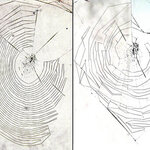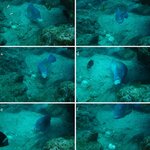The news finally broke last week, months after the first anxious reports of browning and dying trees near lawns and golf courses across America. Unlike their wild cousins in the Rockies and British Columbia, these conifers aren’t dying of pest outbreaks – they’re suffering from pesticides.
It seems that Imprelis, a recently-released DuPont herbicide marketed for environmental friendliness, is poisoning ornamentals like Norway spruce and eastern white pine. Now, DuPont is promising new labeling for Imprelis, the Environmental Protection Agency is reevaluating its approval, and New…
Ecology & Zoology

Giant squid are pretty cool, right? If you want to see one (without having to go fishing) then you have a number of museums to choose from. Specimens and models are abundant enough that Indie Squid Kid put together a giant squid tour: Architeuthis Across America . . . and Beyond! (Someday I'll visit all those giant squid. Someday!)
But what's even cooler than a giant squid? Obviously, a colossal squid. And there is only one colossal squid on exhibit in the whole world. It's at the Te Papa museum in Wellington, New Zealand.
The colossal squid is so awesome that it has boosted traffic not…

Researchers have captured the bioelectrical signals necessary for normal head and facial formation in an organism and captured the process in a time-lapse video that reveals never-before-seen patterns of visible bioelectrical signals outlining where eyes, nose, mouth, and other features will appear in an embryonic tadpole.
The biologists from Tufts University found that before the face of a tadpole develops, bioelectrical signals (ion flux) cause groups of cells to form patterns marked by different membrane voltage and pH levels. When stained with a reporter dye, hyperpolarized (…

A comment thread on my last post has gotten me thinking about the summer of 2009. I lived in La Jolla for a couple of months, sorting baby squid out of old preserved plankton tows, and then trying to identify them. I posted extensively about the experience on my other blog, The Cephalopodiatrist, and though I started this blog shortly thereafter, none of that summer material ever made it here.The entire account, How I Spent My Summer Vacation, is full of strange pictures and tales, so go take a peek if you're interested. I will re-post here only a sample of what my brain can…

My paper on Squid Babies (which started out as a dissertation chapter) just got accepted!
Well, technically it's Accepted with Revisions, which, for the non-academics in the room, means my co-authors and I have to change a few things before it gets published. But still! It's going to get published! This calls for celebration!
So, in honor of Squid Babies, have a gorgeous video by pacificcoast101 on the embryonic development of the California market squid:
Thanks to Kevin Z for posting the video at Deep-Sea News, where I first saw it! The scientific detail and accuracy are truly…

Pesky animal rights activists may complain if you eat veal but they can't complain if you eat larvae, right? Those are bugs and people sitting in trees have to eat something while they keep the forest commission from clearing brush or removing dead trees to prevent wildfires.
The California State Fair is coming up in a few weeks. It is earlier the last few years, because the old August dates were darn hot and with that sumbitch global warming it was only going to get hotter so they moved it back to July and, today, it is a balmy 70 degrees. For residents of the once…
Check out this photo, taken a few weeks ago in La Jolla, Southern California. What do you think is most striking about it?
Some people might be surprised by the sheer number of squid in the photo--but rest assured, that's quite normal. This is the California market squid, a gregarious creature that often travels in large shoals. (Or should I say schools? They certainly seem to be swimming in a coordinated manner.)
Other folks might find the squids' vivid colors astonishing--especially if they've ever purchased a box of market squid for bait or dinner:
Not so vivid.
But remember, live squid…

Good morning/afternoon/evening, and welcome to the Spider News. Today, we have two arachnid novelties for you.
Firstly, old age affects us all, even spiders. Researchers have found that, as spiders age, their webs become messier (see figure 1).
Figure 1: Web from a silver-sided sector spider (Zygiella x-notata) aged 17 days (a youngster) on the left, and from a spider aged 188 days (middle-aged) on the right.(Credit: Mylène Atoneux, Nancy University)
The study was performed to learn more about how aging affects the human nervous system. Studying the effects of age on organisms with…

I don’t care how long (or short) of a time you’ve spent lounging in the Stanford bubble. If you haven’t popped out yet to see a sea otter, I have an assignment for you: Drop everything and get to the coast. Charismatic fur balls await.
Today, sea otters are the poster children of cuddle appeal, but their endearing behaviors were lost on the fur hunters of the 1800s. Otter fur lined jackets (and the fur trade lined pockets), but soon otters no longer lined the Pacific Coast.
The sea otter, however, is a “keystone species” — its impact on our coastal ecosystems is disproportionately large…

Once upon a time, tool use was considered to be a uniquely human feature, setting us apart from the rest of the animal kingdom. But, when Jane Goodall observed chimpanzees using sticks to ‘fish’ for termites (see video 1) in the 1960’s, this idea received a serious blow. Since then, tool use has been observed in a variety of animals, ranging from the usual primate suspects, to less expected critters, such as crows, dolphins, elephants, otters and even octopuses (see video 2).
Video 1: Chimpanzees using tools to 'fish' for termites.
(Source: BBC documentary 'Cousins')
Video 2: Octopus…